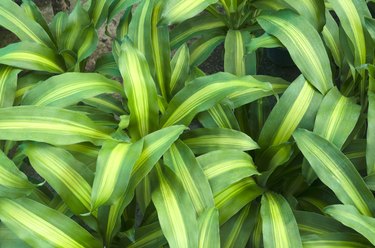
Dracaena fragrans 'Massangeana' is also known as the corn plant. It looks just like a corn stalk with a creamy white to yellowish stripe up the middle of the leaves. As the plants age, the stalk or trunk thickens and becomes leafless. The leaves on older plants grow from the top of the trunk. Corn plants are one of the easiest houseplants to grow successfully. It can be toxic to pets.
Introduction to the Corn Plant
Video of the Day
Corn plants are native to tropical Africa. Wild growing plants can reach a height of 15 to 50 feet and a width of 3 to 10 feet. When cultivated, they grow slowly to a mature height of 4 to 6 feet. The leaves grow to about 2 feet long and 3 to 4 inches wide. The trunk or stalk is dark green on younger plants.
Video of the Day
Corn Plant Exposure and Temperature
Corn plants grow well in a bright sunny room, or a room that gets very little natural light. Do not place the corn plant in drafty locations or in direct sunlight, however, as this will result in leaf scorch. If the plant is in a very low light situation, it may start producing solid green leaves without the cream or yellow stripe up the middle. Move the plant to a brighter location if this happens.
Average household temperatures between 60 and 75 degrees Fahrenheit will keep this plant happy. It can be damaged by temperatures that drop below 55 degrees Fahrenheit. Average household humidity is fine, but if the home is especially dry due to forced air heating or cooling, mist the plant in the morning or set a humidity tray below it.
Corn Plant Water and Soil
Throughout the spring, summer and fall, water corn plants about once each week. Provide a balanced fertilizer at half strength once each month. Be careful not to overwater this plant. Keep the soil slightly moist, but not dripping wet. In late fall and winter, allow the top 2 inches of soil to dry before watering the plant, and do not give it any fertilizer.
Always keep it in a container with drain holes in the bottom and empty the saucer beneath the container after the water drains through. Keep it in potting soil that drains well. Check how well the soil drains by picking up a handful of it a few days after watering and squeezing it. If water drips out of the potting mix, it is not draining quickly enough. Use a potting mix that contains vermiculite or perlite to improve drainage. Only repot corn plants when they become root-bound, which commonly occurs every two to three years. If the potting mix has broken down and is not draining, change the potting mix. Do not put it in a larger container unless it is root-bound.
Corn Plant Flowers
Corn plants bloom in the winter and spring in their native habitat. Older plants, generally those that are more than 6 feet tall, will occasionally bloom when grown as houseplants or outside in warm USDA hardiness zones 10 through 12. The flowers are produced in panicles that can be 3 feet long. They are very fragrant and can be white, yellow, purple or blue. If the flowers are left on the plant, they will give way to red berries. After the plant finishes blooming, a new head of leaves will sprout from the top of the plant right next to where the flower panicle was.